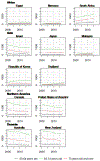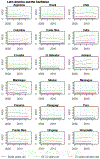Current and projected number of years of life lost due to prostate cancer: A global study
- PMID: 35468227
- PMCID: PMC9246888
- DOI: 10.1002/pros.24360
Current and projected number of years of life lost due to prostate cancer: A global study
Abstract
Background: Prostate cancer is an important cause of death worldwide. The number of years of life lost (YLL) due to prostate cancer is a metric of the toll of prostate cancer and using projections of demographic changes, can be used to measure future burden.
Methods: Prostate cancer mortality data by country and world region was retrieved from the Global Cancer Observatory and the World Health Organization mortality data set, and life expectancy was from the United Nations Department of Economic and Social Affairs. We estimated YLL as the difference between age at death in people with prostate cancer and remaining life expectancy for people of the same age in the general population. We also estimated the age-standardized YLL rates per 100,000 males over 50 and the average annual percentage change in YLL rates over the period 2000-2019 and the number of YLL for the year 2040 by applying population projections to the 2020 YLL rates.
Results: In 2020, 3.5 million person-years of life were lost due to prostate cancer in males over 50, and 40% of YLL were in those aged over 75. Age-standardized rates varied greatly between and within regions. Over the last two decades, rates of YLL have increased in many Asian and African countries while they have decreased in northern American and European countries. Globally, YLL are anticipated to double by 2040 to reach 7.5 million, with the greatest increases in Africa, Asia, and Latin America and the Caribbean.
Conclusion: There are wide variations in the burden of prostate cancer globally as measured by YLL. The burden of prostate cancer is projected to increase over time and appears to be highest in Sub-Saharan Africa, Eastern Europe, and Latin America and the Caribbean. It will be critical to plan and implement programs to reduce the burden of prostate cancer globally.
Keywords: epidemiology; mortality; prostate cancer; years of life lost.
© 2022 Wiley Periodicals LLC.
Conflict of interest statement
Conflict of Interest
The authors declare no conflict of interest.
Figures





References
-
- Sung H, Ferlay J, Siegel RL, et al. Global Cancer Statistics 2020: GLOBOCAN Estimates of Incidence and Mortality Worldwide for 36 Cancers in 185 Countries. CA: A Cancer Journal for Clinicians. 2021;71(3):209–249. - PubMed
-
- Ferlay J, Colombet M, Soerjomataram I, et al. Cancer statistics for the year 2020: An overview. International Journal of Cancer. 2021. - PubMed
-
- Ferlay J, Ervik M, Lam F, et al. Global cancer observatory: cancer today. Lyon, France: international agency for research on cancer. 2018:1–6.
-
- Culp MB, Soerjomataram I, Efstathiou JA, Bray F, Jemal A. Recent Global Patterns in Prostate Cancer Incidence and Mortality Rates. Eur Urol. 2020;77(1):38–52. - PubMed
-
- Schröder FH, Hugosson J, Roobol MJ, et al. Screening and prostate-cancer mortality in a randomized European study. New England journal of medicine. 2009;360(13):1320–1328. - PubMed
Publication types
MeSH terms
Grants and funding
LinkOut - more resources
Full Text Sources
Medical

